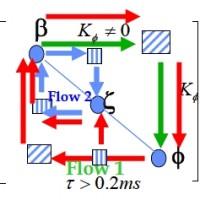The mechanism through which the higher-order rotor dynamics couples with the body dynamics can be understood better by applying “energy-flow methods”. These methods represent a semi-qualitative analysis for identifying the mechanism of a dynamic instability. The idea is that any instability possesses a multiplicity of energy flow paths (vicious circles) in which energy is transferred from one degree of freedom to the other. The method follows the steps:
1) The dynamical equations of motion are written as a set of second-order systems;
2) Each degree of freedom (DOF) is considered as an excitation for the other DOF => the coupling terms are external excitations for each separate degree of freedom;
3) It is assumed that there is “virtual” damping in each degree of freedom such that an oscillation with constant amplitude results. The amount of damping does not depend on the actual damping;
4) Next, one inspects whether there are any external excitations (coupling terms) in phase with the velocity of the degree of freedom considered. If so, the coupling term – “excitation” – pumps energy into or extracts energy from the DOF.
5) If there are degrees of freedom which mutually pump energy into each other, this indicates the possibility of dynamic instability. The reasoning here is that the added virtual damping must continuously dissipate energy to achieve the constant amplitude. If the actual damping is less, then the mutual energy exchange would tend to increase the motion amplitude.
Here is an example of the energy method applied to understand the couplings between flap-lag and body roll motion.



